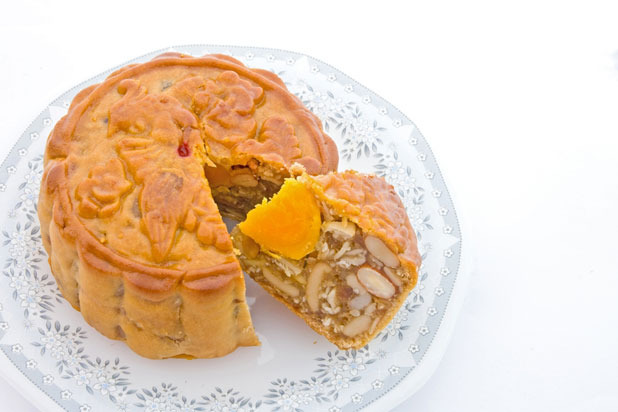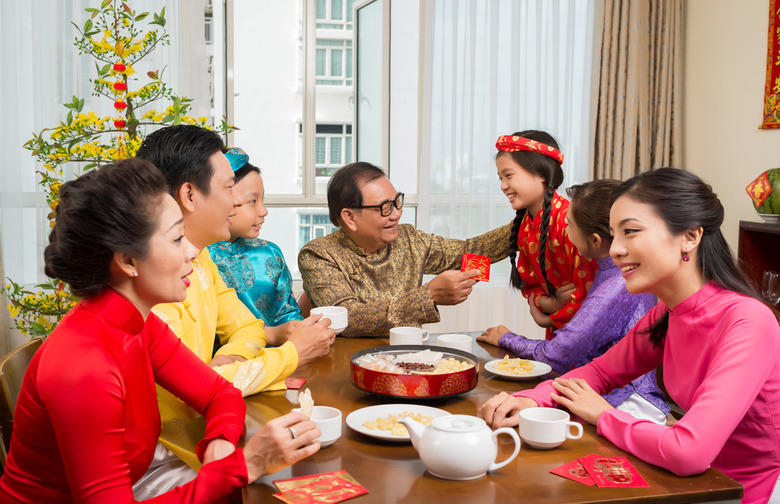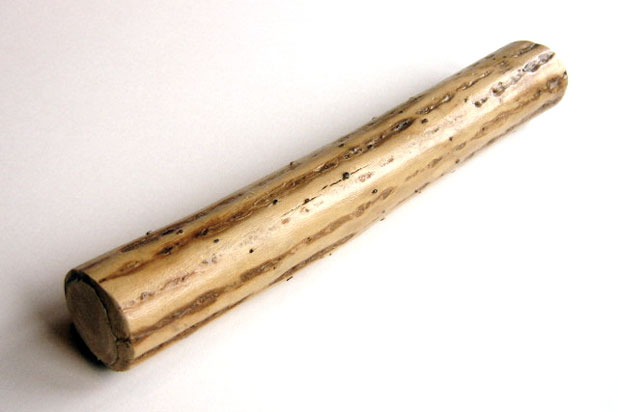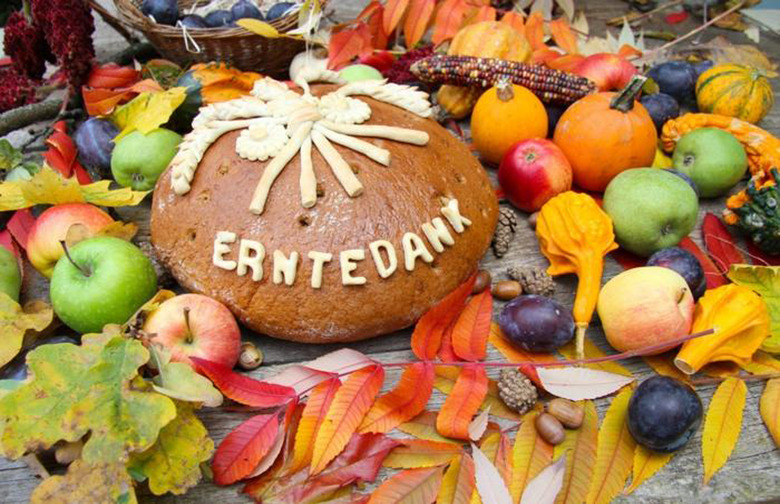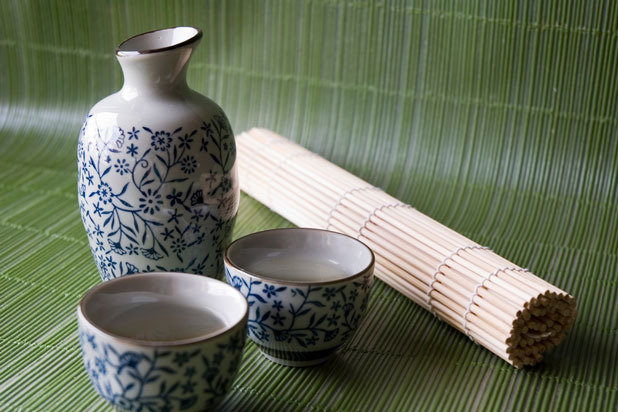10 Thanksgiving Celebrations Around The World Slideshow
Families gather on the 15th day of the eighth lunar cycle to celebrate the autumn harvest. The Chinese reunite with family for a large three-day feast featuring mooncakes sweet cakes filled with sesame seeds, ground lotus seeds, and duck eggs embossed with a baker's insignia. The mooncake's center is filled with a salty yolk (an acquired taste) to represent the full moon. Families and friends often exchange them as a sign of unity and peace.
Celebrate at Home: Chinese mooncakes are an extremely hard delicacy to make, in fact many Chinese people buy them from bakeries already prepped. Challenge yourself with one of the recipes above, one for every skill level. Alternatively, bake something more familiar, like a cookie or a cake, in the shape of a moon. Click here for some kid-friendly ideas to get you started.
Vietnam: Têt-Trung-Thu Festival
Also celebrated on the 15th day of the eighth lunar cycle, and with mooncakes, Vietnamese people give thanks and celebrate their families during what is also known as the Children's Festival. Folklore says that during harvest, parents were so busy that this was a way to make amends for leaving them for so long. Parents would shower their children with love and appreciation, and a candlelit procession at dawn with handmade lanterns.
Celebrate at Home: Thanksgiving dinner is undoubtedly the best part of the day, but getting there can be hectic. Make sure you take time to show your little ones how much you appreciate them by doing something together. Make turkeys for the table, prepare a game, or share stories of what Thanksgivings were like when you were growing up.
South India: Pongal, the Harvest Festival
Today, Pongal is a four-part celebration. The first day, Bhogi Pongal, honors Indra, the king of the gods as well as god of the rain and clouds. Families give offerings to Indra so that their harvest is bountiful. The Sun God, Surya Pongal, is honored on the second day with a special dish called sarkkarai pongal and sugarcane sticks. On the third day, known as Mattu Pongal, cowherds and shepherds pay thanks to their cows and bulls, painting and decorating the animals. On Kaanum Pongal, the final day, people travel to see family members to share their crops and give thanks to a successful harvest.
Celebrate at Home: Celebrate the gods of rain and clouds by making a rainstick with dried rice. Take a paper-towel tube and decorate using anything from stickers to watercolor paints. Once dried, take a square of foil and secure it at one end of the tube with glue or a tightly wound rubber band. Fill with a small handful of rice and seal other end of paper-towel tube. Then listen to the sound of rain.
United Kingdom: Harvest Festival
Saxon farmers would offer the first cut sheaf of corn and a sacrificial animal to one of their fertility gods to ensure a bountiful harvest. It was thought that the Spirit of the Corn lived in that first cut, and the tradition of making plaited corn dolls to hang in rafters each year began in order to protect the rest of the harvest.
Today, the English still make the corn dolls and still celebrate the harvest with a supper that features the season's produce. Children also take gifts of fruit and vegetables to churches and schools, which are distributed to the elderly and needy of the community.
Celebrate at Home: Think about the ways you can give back to your community. Spend the morning in a soup kitchen, or donate canned goods to a local drive. There are plenty of ways to fight hunger in America, and what way to better show how grateful you are by giving back to those in need?
Germany: Erntedankfest
The German harvest celebration is observed in September or October. The day begins with a sermon, followed by a procession in which a traditional harvest crown is presented to the harvest queen, Ernteknigin. The day is further celebrated with music, dancing, and a bounty of fruits and vegetables from the harvest. While it's not a grand day of family get-togethers and feasting like Thanksgiving in America, the unused food is distributed to the needy. There isn't a turkey, either. Instead, chickens are fattened up in time for the feast. In some places, there is also an evening service followed by a lantern and torch parade, with fireworks for the children.
Celebrate at Home: Swap out that turkey for chicken! OK, for some that may be a cardinal sin, but it's an option, especially if you're hosting Thanksgiving for two, or four. Or opt for a hearty soup that also pays tribute to the harvest season, like this hearty pumpkin soup.
Brazil: Day of Thanksgivings
In 1949, what was once a seasonal celebration to express gratitude to the Lord for a good harvest throughout the year, became Dia de Ao de Graas, a day of Thanksgivings, after the ambassador of Brazil was inspired by a visit to the U.S. The celebrations take place on the fourth Thursday of November, yet not all Brazilians partake in the festivities, as it isnt an official holiday. Like in the U.S., there is a turkey and stuffing and accompanying dishes include mashed potatoes, sweet potatoes, corn stuffing, and pumpkin pie. Just as in the U.S., the most important part of the day is that it is full of food, family, and friends.
Celebrate at Home: Be inspired by the wonders of Brazil and serve up favorites likecaipirinhasand other Brazilian favorites alongside your turkey and stuffing.
Ghana: Homowo, or Yam Festival
In the U.S. yams are essential to a traditional Turkey Day table. They are also a major crop in Ghana, and important enough to get their own festival. To ward against famine and to thank the spirits for a bountiful harvest, Ghanians gather to celebrate the important tuber, which are unearthed to be blessed by the chief. The day begins with a ceremony to honor the deceased as well as twins and triplets in the community. Special yam dishes, like mashed yams with hard-boiled eggs, are prepared along with kpekpele, a mashed cornmeal with palm oil. Dressed in multi-colored togas, Ghanians dance to ceremonial drums and end with a large feast.
Celebrate at Home: Candied yams are a fantastic way to bring Ghana to your American table. Or anything with sweet potatoes, for that matter.
Canada: Canadian Thanksgiving
The first Canadian Thanksgiving was celebrated in 1872 in gratitude for King Edward VII's recovery from a serious illness, but it took until 1957 for Parliament to establish the second Monday in October as the official Thanksgiving Day.
Typically, Canadians eat their Thanksgiving meal on Sunday. Similar to the UK Harvest Festival, they decorate churches with cornucopias. Today, much like its southern neighbor, Canada celebrates its holiday with parades, football, and a big turkey on the table.
Celebrate at Home: Celebrate Canada's famous leave by collecting colorful leaves to decorate your home, raking a great pile to jump in, or by making something with maple syrup to serve at your holiday table like butternut squash soup with maple foam or a maple hot toddy?
Barbados: Crop Over Festival
Unlike America's first Thanksgiving where there was no sugar (it was lost on the ride over on the Mayflower), Barbados' celebrations are all about sugarcane. The Crop Over tradition began in 1688, and it begins with a ceremonial delivery of the last canes, followed by the presentation of harvest crowns to the man and woman who produced the most sugarcane. Partygoers enjoy fish cakes and barbecued chicken from nearby stands, and challenge others to climb greased poles or partake in feasting and drinking competitions. The event culminates with the Grand Kadooment a parade with mummer-esque bands dressed in elaborate costumes depicting various themes.
Make it Your Own: Bring a bit of Barbados' prize crop to your table by decorating with sugarcane, or serving up this signature cocktail.
Malaysia: "Kadazan Harvest” Celebration
What is just a side dish to us in the U.S., is a point of celebration in Sabah, Malaysia: Rice. This religious holiday is observed in May, after a season in the rice patties, to honor the rice god, Semangat, to offer gratitude for the good harvest.
Carnivals are an important part of the celebration, as are cultural programs, agricultural shows, buffalo races, and traditional games.Homemade rice wine is distributed among locals dressed in traditional costumes.
Celebrate at Home: There are of course numerous rice dishes you could make to bring this Malaysian tradition to your home. But for an interesting twist, you could introduce your loved ones to the rice wines,like sake, that are so popular at the festivals.
